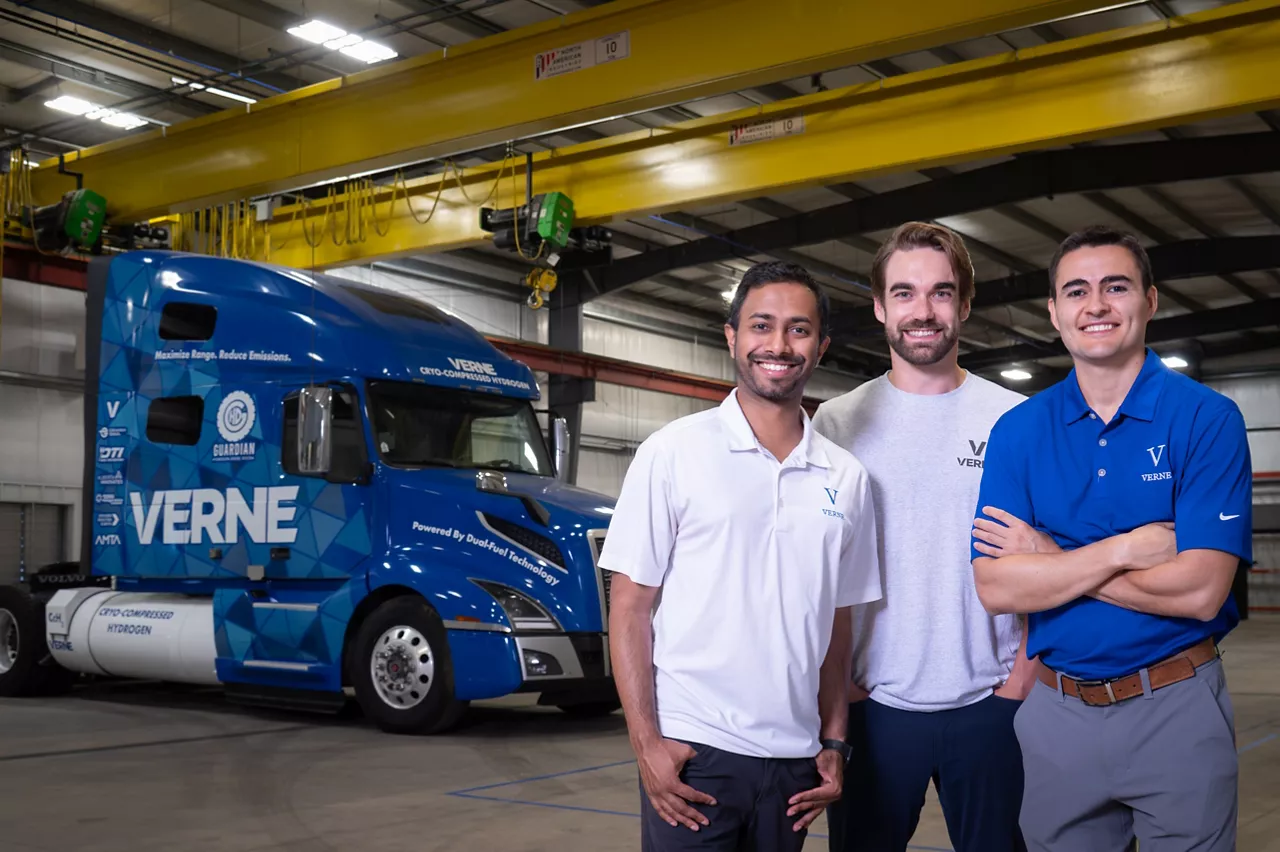The parties will develop high-flow, flexible hoses to support fueling heavy-duty vehicles with cryo-compressed hydrogen
San Francisco, California & Newton Square, PA July 23, 2024 — Verne and LifeGuard Technologies announced a Memorandum of Understanding to develop high-flow, flexible safety hoses for cryo-compressed hydrogen fueling of heavy-duty vehicles. The two companies will collaborate to accelerate the development of the refueling hoses with the goal of entering commercial production in 2027.
Heavy-duty transportation is responsible for 12% of U.S. greenhouse gas emissions, and current zero-emission solutions do not meet the needs of heavy-duty vehicles. Battery electric trucks provide limited range and add 5,000+ pounds to the weight of the truck, reducing the payload available to haul cargo. Current hydrogen trucks, which store hydrogen as a compressed gas onboard, offer improved performance relative to battery electric trucks but still fail to meet the required range and payload of heavy-duty vehicles. Cryo-compressed hydrogen (CcH2) achieves an 87% improvement in density relative to 700 bar compressed hydrogen and a 33% improvement over liquid hydrogen, allowing CcH2 trucks to achieve diesel-equivalent range and payload.
Development of new infrastructure and components is required to support commercialization of CcH2,and Verne and LifeGuard’s partnership will establish a US-based supply of high-flow CcH2 safety hoses that enable fueling of trucks and other heavy-duty vehicles. The partnership will combine LifeGuard’s expertise in safety-critical solutions for cryogenic fluid transfer and Verne’s expertise in CcH2 and access to world class testing facilities. The partners will collaborate to develop and test hoses suitable for refueling heavy-duty vehicles with CcH2in less than 10 minutes.
Cryo-compressed hydrogen is a platform technology with applications across heavy-duty transportation and hydrogen distribution. The flexible hose technology can be adapted to serve sectors including trucking, aviation, port vehicles, mining and maritime transportation.
Verne develops cryo-compressed hydrogen storage tanks and refueling equipment that converts gaseous hydrogen into CcH2. In 2023, Verne completed drive testing of a CcH2 storage system onboard a vehicle and demonstrated a world-record 29 kg storage tank at Lawrence Livermore National Laboratory, equivalent to the tank size that would be used in heavy-duty trucking. Verne recently announced the first demonstration of CcH2 onboard a Class 8 Truck, set to take place in late 2024.
Verne is focused on developing the supplier base for CcH2. In November2023, Verne announced a partnership with ARTA to develop nozzles and receptacles for CcH2 fueling. Last month, Verne and Cryostar announced a new partnership to develop pumps for “future-proofed” hydrogen fueling stations. Verne’s partnership with LifeGuard Technologies is an important next step in enabling the full ecosystem of suppliers for CcH2 fueling solutions.
“The trucking industry is demanding greater vehicle range and lower weight than current zero-emission options offer, and cryo-compressed hydrogen is well placed to meet the need given its greater hydrogen storage density,” said Ted McKlveen, Co-founder & CEO of Verne. “LifeGuard is a best-in-class developer of flexible safety hoses and is the ideal partner for developing the solutions needed to enable a massive transition to CcH2.”
“At a time when the hydrogen industry is on the cusp of massive expansion, it is critical that safety leads the way. Now, high-flow CcH2 hydrogen transfer hoses will have the same technological safety features that our CNG, LPG,NH3 and high pressure hydrogen and atmospheric gas hoses have enjoyed for more than 20 years,” stated Andy Abrams, Executive Vice President of LifeGuard Technologies. “We look forward to working with Verne, a true leader in the hydrogen industry, and to offering this new hose design to our Compressed Gas and Petrochemical customers through our global network of locations helping to drive LifeGuard Safety Hose adoption even further into the hydrogen industry.”
About Verne
Verne was founded in 2020 to develop high-density hydrogen storage solutions required to decarbonize heavy-duty transportation. Verne’s platform unlocks zero-emission operations in sectors including trucking, aviation, port vehicles, mining, and hydrogen distribution. Verne is financially supported by leading commercial entities, including Trucks Venture Capital, Collaborative Fund, Amazon’s Climate Pledge Fund, Next Era Energy Resources, United Airlines Ventures Sustainable Flight Fund, Caterpillar VC, and Newlab. Verne is also supported by Breakthrough Energy Fellows, the Department of Energy’s ARPA-E, The U.S. Army, Alberta Innovates and other agencies.
For more information, visit www.verneh2.com.
Company contact: contact@verneh2.com
About LifeGuard Technologies
LifeGuard Technologies is a safety technology company with its headquarters in Philadelphia, Pennsylvania and satellite affiliated factories in Bethlehem, PA; Ontario, Canada; Motala, Sweden; Faridabad, India and Melbourne, Australia. The company’s patented and patent-pending safety hose technology has become a global standard for all industries, applications and pressures. The company’s roots began with Joe Abrams’ work in cryogenics in 1958 – and today, the company has hoses worldwide in all industries and applications. More than 500,000 hoses with this technology have been sold since its invention including to all Tier One and Tier Two gas companies, making it the ‘Hose of Choice’ for the industrial and compressed gas industry.
For more information, visit: https://lifeguard-tech.com/
Company contact: info@lifeguard-tech.com


.png)


